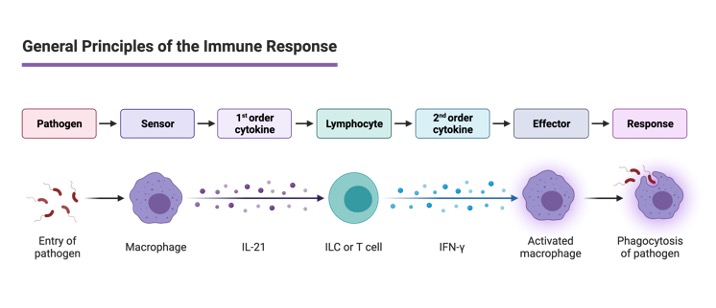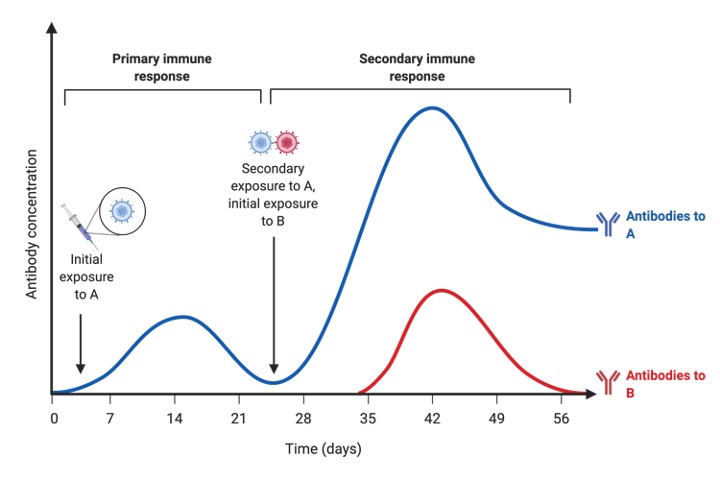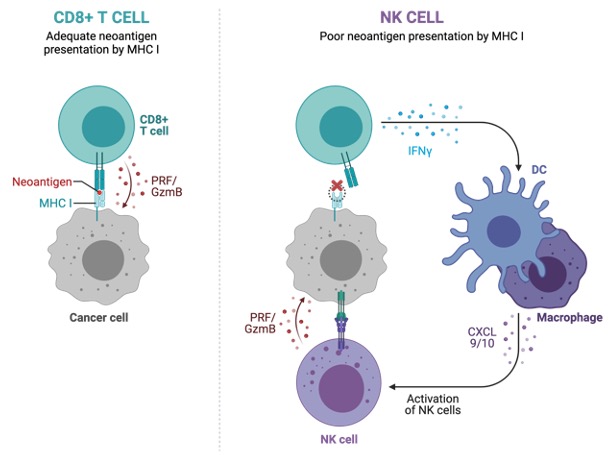Table of Contents
Immune Response Definition
The body’s reaction to the presence of a foreign material (i.e. antigen) is referred to as an Immune Response.
What is Immune Response?
Any of the body’s responses to a foreign material, such as an antigen, is referred to as an immune reaction. The response aims to defend the body from viruses, fungi, bacteria, and parasites that might cause illness. When a transplanted organ is recognised as non-self, it might trigger an immunological reaction.

An immune response in vertebrates, including humans, can take the form of antibody formation, cell-mediated immunity induction, complement activation, or the establishment of immunological tolerance.
Exogenous, endogenous, and autoantigens are all examples of antigens. Antigens that can enter the human body are known as exogenous antigens. Allergens, proteins from donated tissues and organs, compounds on foreign cell surfaces, poisons, and other foreign particles are examples.
Endogenous antigens are those generated within the cell and shown on the cell surface, such as when the cell is infected with bacteria or viruses. Autoantigens are endogenous antigens that the immune system mistakenly interprets as nonself.
Humoral Immune Response
This type of immune response is known as humoral immune response, and it is defined by the production of humoral antibodies in response to an antigenic challenge. The antigen is identified by the immune system, which triggers an immunological response to kill the cell or particle carrying the antigen.

B cells are immune cells that play a role in the synthesis and release of antibodies, also known as immunoglobulins. A Y-shaped structure, consisting of two heavy chains and two light chains, is the basic structural unit of an immunoglobulin. The variable and constant regions are found in each of these chains.
The antigen-binding site is located in the variable area, which is the apical part. This is an antigen-specific site. This is significant because the immunoglobulins will be able to detect and neutralise these antigens the next time they come into contact with them. B cells release immunoglobulins when they are able to detect antigens, i.e. when their cell receptors, known as BCRs, attach to particular antigens.
As a result, the first antibodies produced by a new B cell will be those that are found on the cell surface and act as antigen receptors. When an antigen attaches to one of these receptors, it activates intracellular signalling cascades. The antigen binds to B cells, causing them to become activated (with the aid of a helper T cell).
The activated B cell will multiply and develop into an antibody-secreting effector cell, which produces soluble immunoglobulins that have the same antigen-binding site as the antigen receptor that detected the antigen.
Cell-mediated Immune Response
The body responds to antigens through the immunological activity of various immune cells, notably T cells, phagocytes, natural killer (NK) cells, and cytokine-releasing cells, in the cell-mediated immune response.

T-cell mediated immunity is a type of immunological response in which T cells play a role. Antigen presentation by an antigen-presenting cell (APC), antigenic peptide recognition by the T cell, and the T cell’s post-antigen detection reaction are all part of the process.
In certain cases, macrophages, dendritic cells, and B cells are examples of APCs. They place antigenic peptides on the cell’s surface, known as the Major Histocompatibility Complex (MCH). When a cell is infected with viruses or bacteria, for example, antigen presentation occurs.
T-cell receptors (TCRs) on the T cell’s surface can recognise particular peptide antigens presented by the APC. The T cell proliferates and differentiates into an effector cell as a result of this.
There are three types of effector T cells:
- CD8 T cells that differentiate into cytotoxic T cells after detecting peptide antigens on MHC class I APCs harbouring intracellular pathogens.
- CD4 T cells that differentiate into helper T cells 1 (TH1 cells) after detecting peptide antigens on MHC class II APCs harbouring pathogens within their vesicles.
- CD4 T cells that differentiate into helper T cells 2 (TH2B cells are induced to generate antibodies by helper T cells.
Phagocytes (for example, macrophages) utilise phagocytosis to destroy germs and viruses they come across. Pathogens are killed by cytotoxic granules secreted by NK cells. The production of cytokines by some cells is another type of cell-mediated immune response. Cytokines (including erythropoietin, interferon, interleukins, and G-CSF) are immunomodulators produced by lymphocytes, macrophages, mast cells, fibroblasts, endothelial cells, and stromal cells.
Immunological Tolerance
Immune tolerance is necessary to prevent the immune system from overreacting. Otherwise, the immune system might become excessively sensitive, leading to illnesses like autoimmune diseases.
Altered Immune Responses
Disorders can result from a lack of an efficient immune response. Autoimmunity is a condition in which the body misidentifies its own chemicals and tissues as antigens. Celiac disease, systemic lupus erythematosus, and diabetes mellitus type 1 are all autoimmune illnesses caused by this syndrome. Gammopathy is another. Gammopathy is an immunological disease in which cells that produce immunoglobulins proliferate abnormally.







